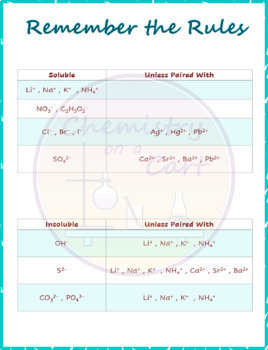

For compounds containing halides, if the compound also contains silver, mercury(I), or lead(II) ions, the compound would then be insoluble in water. Compounds that are generally water-soluble and would not form a precipitate contain alkaline metal cations, ammonium cations, nitrate anions, bicarbonate anions, chlorate anions, acetate anions, halide anions, or sulfate anions.Ĭompounds containing halides or sulfate ions have some exceptions to their solubility in water. We can use the water solubility rules to predict which product will be insoluble in water. A precipitate can be formed from a reaction with reactants that are often both aqueous or, in other words, dissolved in water that when mixed together react to form the insoluble compound that is the precipitate and most likely another aqueous compound. A precipitate is an insoluble product that separates from a solution. We must identify the reaction where one of the products is a precipitate.
#Precipitate rules plus
(B) Ca(OH)2 aqueous plus two HCl aqueous. All other acids and bases will be considered weak for the purpose of this course.For which of the following reactions is a precipitate likely to form? (A) Pb(NO3)2 aqueous plus MgSO4 aqueous. The table below contains the strong acids and bases you need to know. The concentration of H + based on this dissociation is 1.0 x 10 -7M and when we take the pH of this value (-log(1.0 x 10 -7)) it equals 7 which is defined as neutral pH.įor now we will concentrate on the reactions of strong acids and bases. This is because the products of the reaction do not contribute any protons or hydroxide ions to the solution beyond the normal dissociation of water in water which is a very small amount (Dissociation constant Kw = 1.0x 10 -14 ). When you react the acid and base, this process is called neutralization. If we look at the net ionic equation for this reaction it shows that the driving force for the reaction is the production of water:

NaCl is the salt is this reaction and you already know water. So now that we know what they are, what do we do with them? Well, whenever an acid and a hydroxide base are reacted together they always produce the same two types of products: a salt and water.Įxample: HCl(aq) + NaOH(aq) → NaCl(aq) + H 2O(l) Base Defined = a chemical species that donates electrons or hydroxide ions or that accepts protons in reactions. Acid Defined = a molecule or other entity that can donate a proton or accept an electron pair in reactions.

We define a base by its ability to absorb protons from solution. Bases on the other hand are generally recognizable by the presence of a hydroxide ion in their formula: Na OH, Ba( OH) 2 etc. An acid is defined by its ability to donate this hydrogen (also called a proton) when it is in aqueous solution. Acids and BasesĪs we saw when we were working on nomenclature, acids can be identified by the way their formula is written with the ionizable hydrogens at the front of the molecule: HCl, H 2SO 4 etc. Now on to the second part of this reactions lecture. In order to practice these reactions you need to spend some time first working with the rules and then use the questions below to test yourself. The net ionic equation for this reaction will only involve those ions that form the solid so: Identification of AgI as a solid comes from the exceptions to the rules for halides in the table above. Now swap the positive ions and make the new compounds being sure to balance the charges so that the compound is neutral.Īg + + NO 3 - + K + + I -→ AgI(s) + KNO 3(aq) The best way to complete this process and correctly predict the products is to take each of the reactants apart into their ions: This is a fancy word for "swapping partners" as a reaction. In order to answer the question you must realize that this is a Metathesis reaction. What are the products for the following reaction? In other words will it form any compounds that drive the reaction in the forward direction. Typical questions regarding a precipitation reaction will require the identification of the Net Ionic Equation which we covered previously or will be a simple question asking that you complete a reaction and determine if it will make product or not. Writing a Precipitation Reaction Equation: Note that there are exceptions to most of the rules. The table above will be the few rules that you are expected to memorize. Unfortunately the only way to know is to memorize some solubility rules:

The trick to understanding a precipitation reaction is knowing which compounds that form are not soluble.


 0 kommentar(er)
0 kommentar(er)
